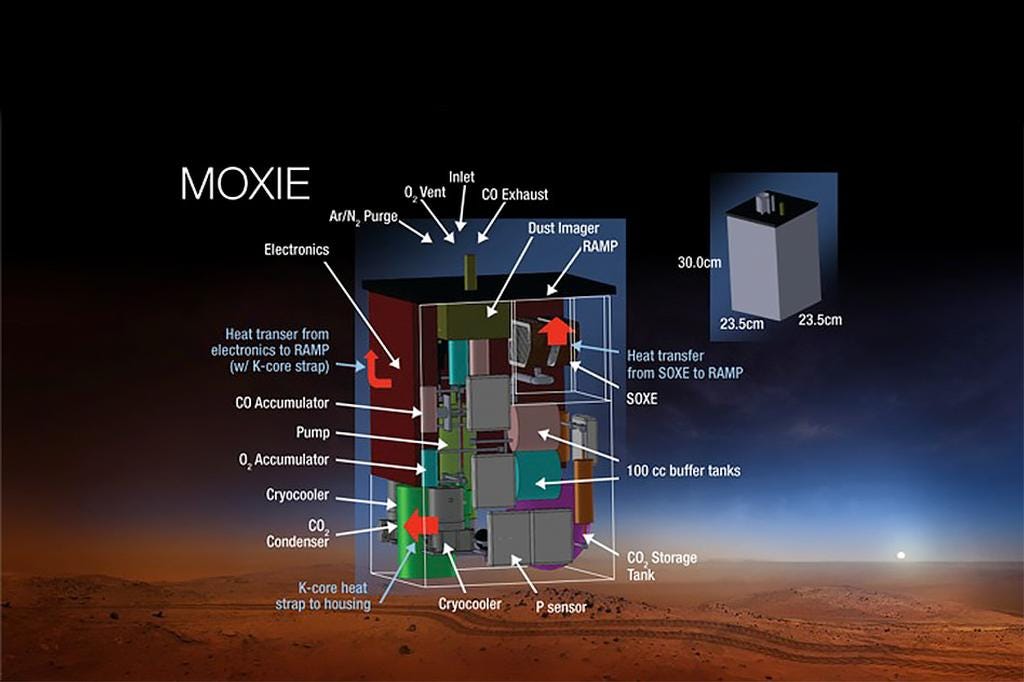NASA's Perseverance Mars rover launched from Cape Canaveral, Florida, on 30 July, carrying a host of cutting-edge technology including high-definition video equipment and the first interplanetary helicopter.
Many of the tools are designed as experimental steps toward human exploration of the red planet. Crucially, Perseverance is equipped with a device called the Mars Oxygen In-Situ Resource Utilization Experiment, or MOXIE: an attempt to produce oxygen on a planet where it makes up less than 0.2 percent of the atmosphere.
Oxygen is a cumbersome payload on space missions. It takes up a lot of room, and it's very unlikely that astronauts could bring enough of it to Mars for humans to breathe there, let alone to fuel spaceships for the long journey home.
That's the problem MOXIE is looking to solve. The car-battery-sized robot is a roughly 1 percent scale model of the device scientists hope to one day send to Mars, perhaps in the 2030s.
Like a tree, MOXIE works by taking in carbon dioxide, though it's designed specifically for the thin Martian atmosphere. It then electrochemically splits the molecules into oxygen and carbon monoxide, and combines the oxygen molecules into O2.
It analyses the O2 for purity, shooting for about 99.6 percent O2. Then it releases both the breathable oxygen and the carbon monoxide back into the planet's atmosphere. Future scaled-up devices, however, would store the oxygen produced in tanks for eventual use by humans and rockets.
 A breakdown of the components inside the MOXIE oxygen generator. (NASA/Wikimedia Commons)
A breakdown of the components inside the MOXIE oxygen generator. (NASA/Wikimedia Commons)
The toxicity of the carbon monoxide produced isn't a worry, according to Michael Hecht, a principal investigator for MOXIE. The gas reenters the Martian atmosphere but won't alter it very much.
"If you release the carbon monoxide into the Mars atmosphere, eventually it will combine with a very small amount of residual oxygen that's there and turn back into carbon dioxide," Hecht previously told Business Insider.
For that reason, the carbon monoxide also wouldn't hinder a potential biosphere on Mars – a closed, engineered environment where Earthly life could thrive.
Because MOXIE is a small proof-of-concept experiment, it won't produce much oxygen – if all goes well, it should be producing about 10 grams per hour, which is roughly the amount of oxygen in 1.2 cubic feet of Earth air. For context, humans need about 19 cubic feet of air per day.
MOXIE will test its capabilities by producing oxygen in one-hour increments intermittently throughout the duration of Perseverance's mission, according to NASA. The device should start working soon after the rover lands on 18 February 2021.
This article was originally published by Business Insider.
More from Business Insider:
"device" - Google News
August 09, 2020 at 06:33AM
https://ift.tt/2DRDKpx
NASA's Rover Is Taking a Tree-Like Device That Converts CO2 Into Oxygen to Mars - ScienceAlert
"device" - Google News
https://ift.tt/2KSbrrl
https://ift.tt/2YsSbsy
Bagikan Berita Ini















0 Response to "NASA's Rover Is Taking a Tree-Like Device That Converts CO2 Into Oxygen to Mars - ScienceAlert"
Post a Comment